
環境物質-三聚氰胺-會造成慢性腎臟病患者的腎臟急速惡化
慢性腎臟病是一個全球性的公共衛生問題。在台灣,每十人就有一人罹患慢性腎臟病,慢性腎臟病也擠身於台灣人口十大死因之一。腎臟是個沉默的器官,往往發生異常而不自覺,當有明顯症狀時已來到洗腎的十字路口,如何能提早並預防慢性腎臟病的發生及惡化,是政府機關及臨床照護人員努力的方向。造成慢性腎臟病的原因很多,仍有許多未知的病因造成慢性腎臟病的發生,除了糖尿病、高血壓、腎絲球腎炎等常見造成慢性腎臟病的原因外,日常生活接觸到的環境物質也可能誘發慢性腎臟病。
在2008年,中國發生毒奶粉事件,奶粉原料中被添加了三聚氰胺(melamine),造成嬰幼兒們腎結石,進而引發腎衰竭。在日常生活裡,三聚氰胺常被用來做成美耐皿餐具,即所謂的熱塑性塑膠產品,民眾在不知不覺裡食入或是接觸到過多的三聚氰胺,因此蔡宜純醫師、腎臟內科與環境醫學中心合作來探討三聚氰胺和慢性腎臟病預後進展的關聯性。研究團隊對293位早期慢性腎臟病(stage 1~3)進行長達七年的觀察,結果發現尿液三聚氰胺濃度較高的病人其血清肌酸酐較容易上升2倍、腎絲球過濾率下降速率較快,且腎絲球過濾率也容易在兩年內就下降30%。從本研究結果可知慢性腎臟病病人,其尿液三聚氰胺濃度和腎臟功能的快速惡化有顯著相關,尿液三聚氰胺濃度較高的病人有較差的臨床腎臟預後。此研究成果不但提供給政府機關三聚氰胺對腎臟影響的警訊,也提醒民眾減少生活中熱塑性塑膠產品之使用,進而維護腎臟的健康。
論文第一作者是醫學院教授蔡宜純醫師。通訊作者為環境醫學中心吳明蒼教授。感謝高醫附院腎臟內科團隊陳鴻鈞教授、黃尚志教授及邱怡文主任、及環境醫學中心團隊吳佳芳博士、劉家駒教授及謝翠娟副教授的協助。
論文全文: https://cjasn.asnjournals.org/content/14/8/1133.long
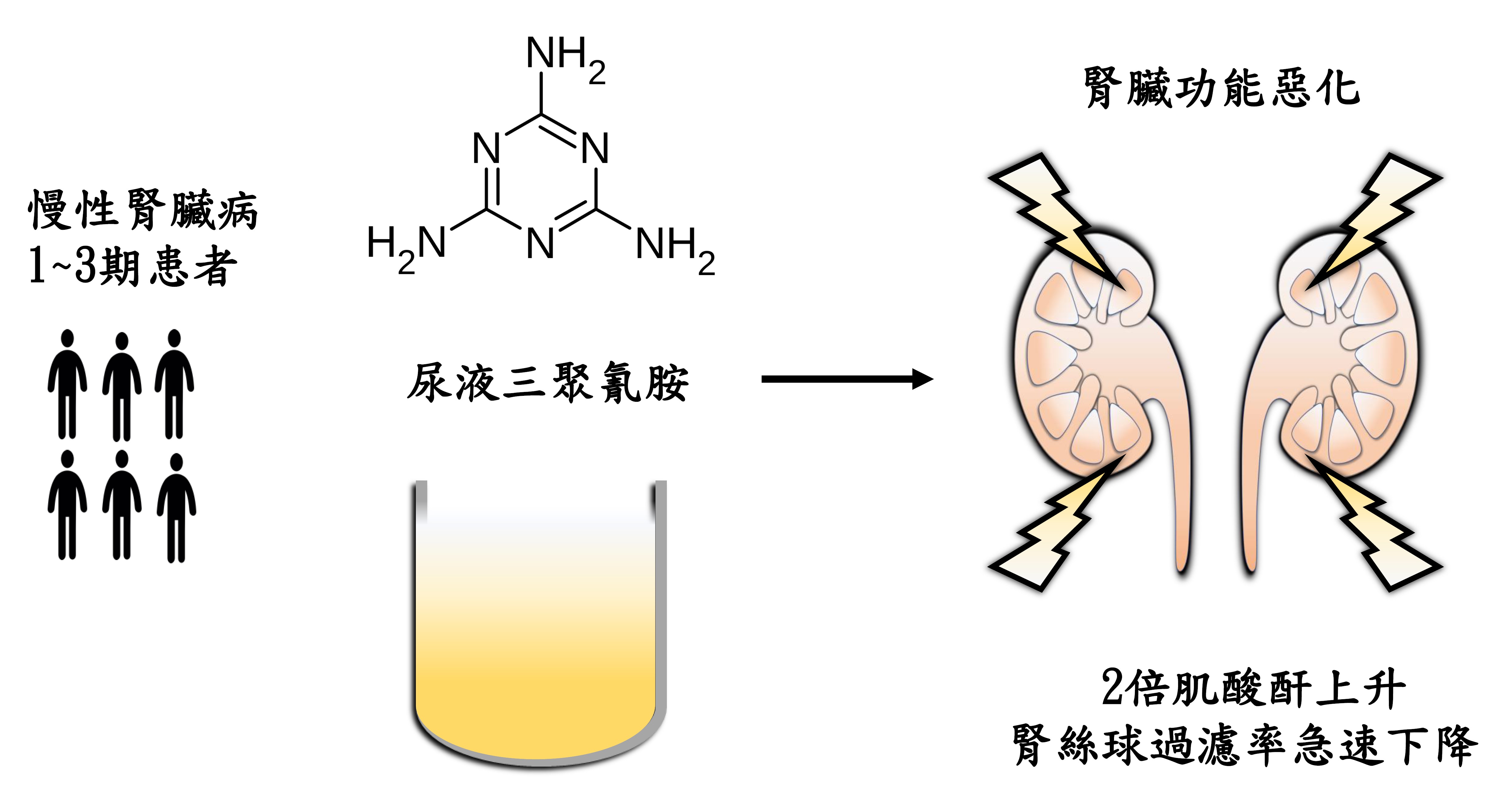
圖示來源: https://cjasn.asnjournals.org/content/14/8/1133.long
圖說: 293位早期慢性腎臟病(1~3期)病人,在7年的觀察期中,尿液裡三聚氰胺濃度較高的患者與濃度較低的患者相比,腎臟功能容易快速惡化。
Urinary Melamine Levels and Progression of Chronic Kidney Disease
Chronic Kidney Disease (CKD) is a global public health problem. The etiology of development and progression of early CKD is multifactorial. Some cross-sectional studies have associated environmental melamine exposure with kidney diseases, but evidence is limited. Professor Yi-Chun Tsai and colleagues at Division of Nephrology, Kaohsiung Medical University Hospital, and Research Center for Environmental Medicine, Kaohsiung Medical University demonstrated urinary melamine as a predictor of rapid decline in kidney function in patients with CKD stages 1-3.
This is the first study to find an association between environmental melamine exposure and adverse kidney outcomes in a clinical setting. Over a median follow-up period of 7.0 years, subjects in the highest tertile of urinary melamine level had a 2.30 hazard risk for doubling of serum creatinine, compared to those in the lowest tertile. Similar significant dose-response results were found in estimated glomerular filtration rate (eGFR) decline > 3 ml/min/1.73m2 per year and 30% decline in eGFR in the first two years. Urinary melamine level is significantly associated with kidney function deterioration in early stage CKD patients. Moreover, research team performed subgroup analysis and demonstrated the association between urinary melamine and kidney function deterioration in subjects with baseline eGFR ≥ 45 ml/min/1.73m2 and in subjects with diabetes mellitus.
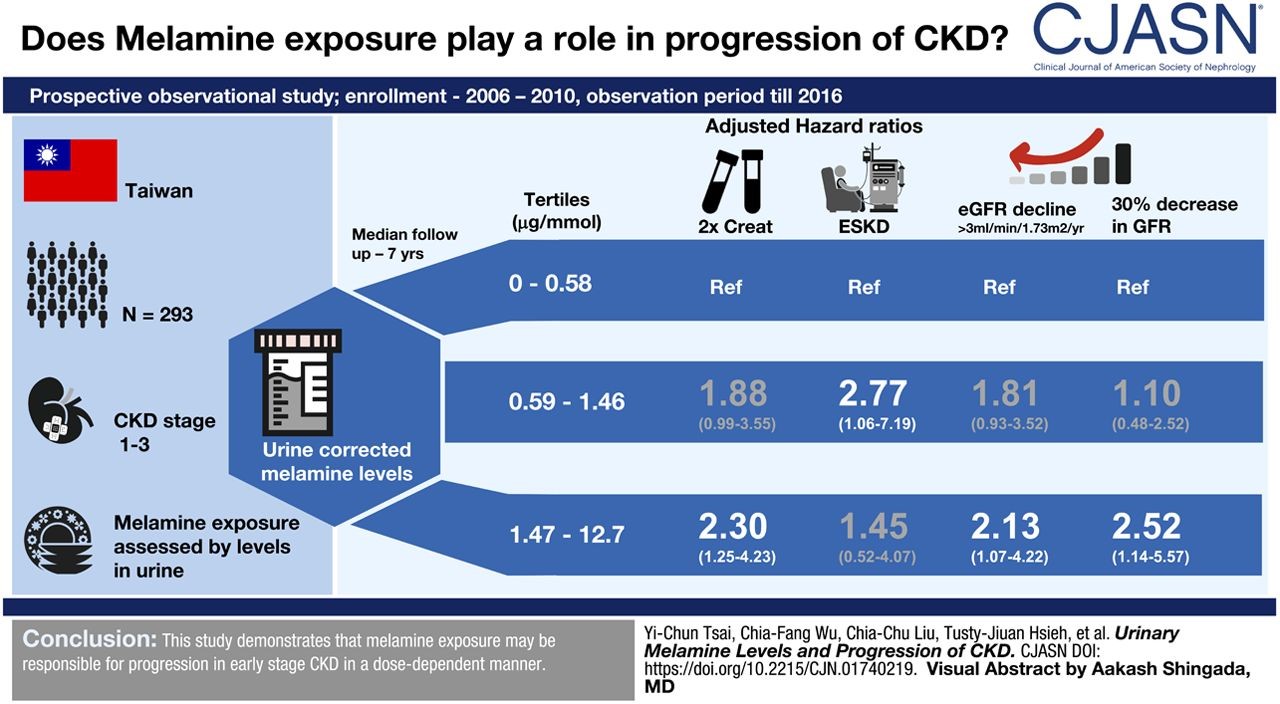
CKD patients with the highest tertile of urinary melamine was associated with rapid decline in kidney function including doubling of serum creatinine, estimated glomerular filtration rate (eGFR) decline > 3 ml/min/1.73m2 per year and 30% decline in eGFR in the first two years compared to those in the lowest tertile. Figure source was from https://cjasn.asnjournals.org/content/14/8/1133.long
This article-“Urinary Melamine Levels and Progression of Chronic Kidney Disease” , written by Rept. Author Professor Yi-Chun Tsai, from College of Medicine, is award for Kaohsiung Medical University 2019 Monthly Excellent Paper Award in Aug. The authors of this article include Dr. Yi-Chun Tsai and her colleagues at Division of Nephrology, Kaohsiung Medical University Hospital (Dr. Yi-Wen Chiu, Professor Shang-Jyh Hwang, and Professor Dr. Hung-Chun Chen and colleagues at Research Center for Environmental Medicine, Kaohsiung Medical University Hospital (Professor Ming-Tsang Wu, PhD Chia-Fang Wu, Professor Chia-Chu Liu, and Associate Professor Tusty-Jiuan Hsieh).
This study was published online in Clinical Journal of American Society of Nephrology the 7th August 2019. The full research article entitled “ Urinary Melamine Levels and Progression of Chronic Kidney Disease”
is available online through CJASN at https://cjasn.asnjournals.org/content/14/8/1133.long.
使用水作為良性反應介質的銅催化合成4-喹諾酮類的合成
在最近的研究中,高雄醫學大學開發了三組分合成且對環境無害的銅催化方法,對於取代的4-喹諾酮衍生物製備效果很好。研究人員開發了一系列4-喹諾酮類藥物的合成方法,並且成功應用於歐索林酸 (Oxolinic acid)殺菌劑與BQCA藥物的合成。由於以往的合成方法有些缺點,限制了它們的適用性,王志鉦教授的團隊發表以三組分:氨水、3-(2-鹵代苯基)-3-氧代丙烷、醛類在銅催化下,一步合成4-喹諾酮衍生物。這各方法具有應用價值且對環境無害。研究人員也進行了克級反應和藥物合成應用,證明了該方法的實用性。此外,其它取代基例如-CN,-NO2,-SO2Ar,-COAr和雜環化合物與甲醛的反應也可順利進行反應,其廣泛性也獲得證實。
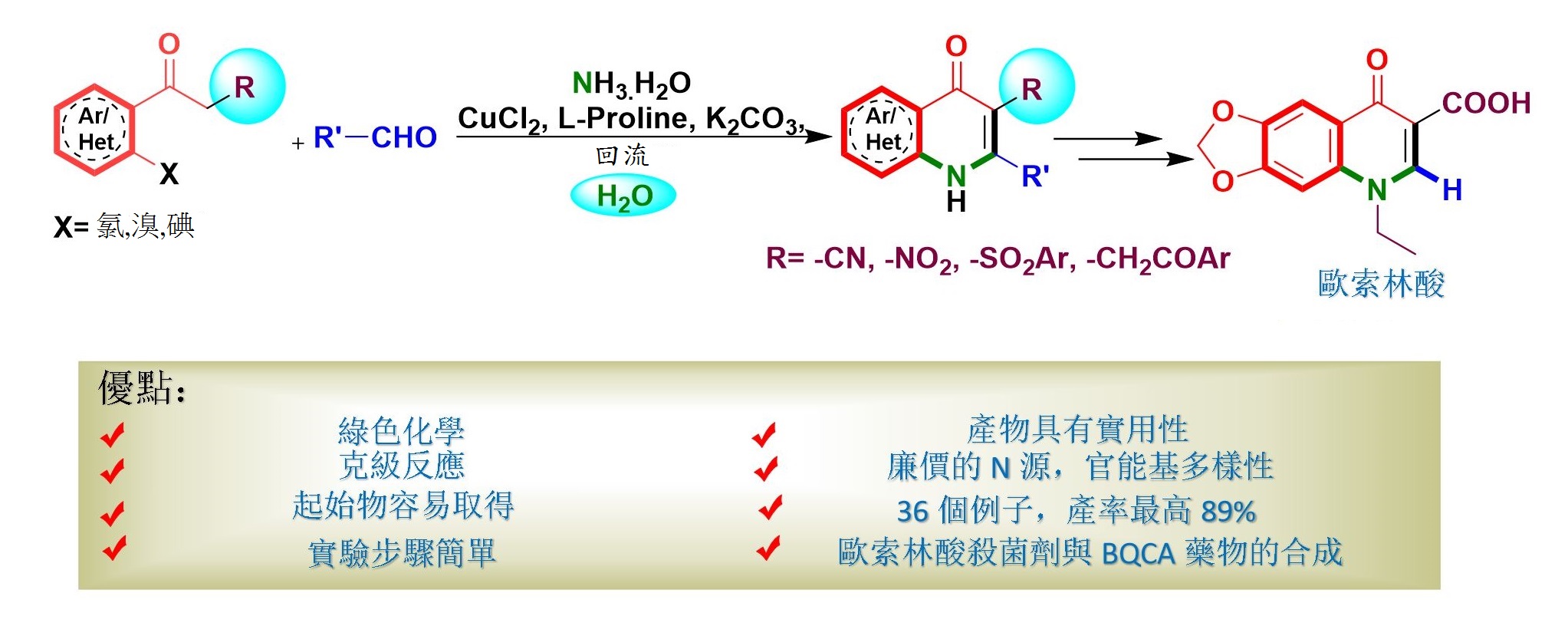
本篇為高雄醫學大學2019年月傑出論文7月份得獎文章,代表作者為醫藥暨應用化學系王志鉦教授。這項工作的主要作者為Babasaheb Sopan Gore (博士生),李建中 (碩士生),李芷怡(大學生)與通訊為作者王志鉦(高雄醫學大學醫藥暨應用化學系教授)。
這項工作於2019年4月1日發表在《高級合成與催化》上(Adv. Syn. & Cat. 2019, 361, p3373-3386)。文章的全名是“使用水作為良性反應介質的銅催化合成4-喹諾酮類的合成,可在以下網站在線獲取https://onlinelibrary.wiley.com/doi/epdf/10.1002/adsc.201900286.
聯絡信息:
台灣高雄市三民區十全一路100號
高雄醫學大學醫藥暨應用化學系王志鉦教授
電話:(886)-7-3121101 傳真:(886)-7-3125339,
電子郵件:jjwang@kmu.edu.tw
高雄醫科大學博士後研究員Babasaheb Sopan Gore博士
電話:(886)- 68930195,電子郵件:gorepranav99@gmail.com
Application for the Construction of Oxolinic Acid and BQCA
A copper-catalyzed three-component environmentally benign synthetic method has been developed for the synthesis of substituted 4-quinolone derivatives. In recent study, the researchers at Kaohsiung Medical University have developed a series of 4-quinolones. This method has been successfully applied for the synthesis of available oxolinic acid and BQCA drugs. Traditional synthetic methods limited their applicability due to the requirement of crucial starting precursors, harsh reaction conditions, side product formation and utilization of organic solvents. Thus, considering this facts, the scientist Jeh-Jeng Wang and his colleagues reported water mediated three-component green and sustainable protocol from substituted 3‐(2‐halophenyl)‐3‐oxopropanes, aq. NH3, and aldehydes for the synthesis of valuable N-heterocyclic compounds. In addition, the researchers also demonstrated the synthetic practicality and synthetic application of this strategy; a gram scale reaction and late stage modification of designed product performed. The researchers utilized aq. ammonia as a N1 synthon for the construction of 4-quinolones. Moreover, the researchers extended this reaction with formaldehyde, and other functionalities such as -CN, -NO2, -SO2Ar, -COAr and heterocyclic compounds.
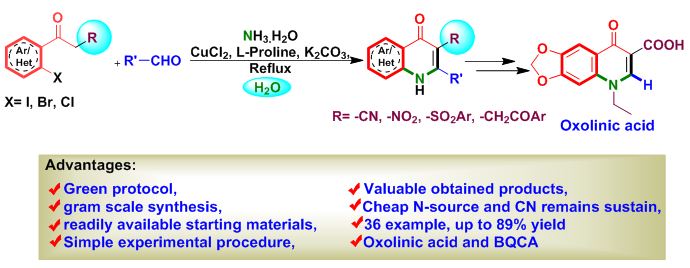
Scheme: Synthesis of 4-Quinolone analogues.
This work was published online in Advanced Synthesis & Catalysis the 1st April 2019. The full name of article entitled “Copper‐Catalyzed Synthesis of Substituted 4‐Quinolones using Water as a Benign Reaction Media: Application for the Construction of Oxolinic Acid and BQCA” is available online through the Adv. Synth. Catal. at: https://onlinelibrary.wiley.com/doi/epdf/10.1002/adsc.201900286.
The lead author of this work “Copper‐Catalyzed Synthesis of Substituted 4‐Quinolones using Water as a Benign Reaction Media: Application for the Construction of Oxolinic Acid and BQCA” are Dr. Babasaheb Sopan Gore, Chein-Chung Lee, Jessica Lee and corresponding author include Jeh-Jeng Wang. ( Professor, Department of Medicinal and Applied Chemistry, Kaohsiung Medical University, Taiwan)
This article-“Copper-Catalyzed Synthesis of Substituted 4-Quinolones using Water as a Benign Reaction Media: Application for the Construction of Oxolinic Acid and BQCA” , written by Rept. Author Jeh-Jeng Wang fom Department of Medicinal and Applied Chemistry, is award for Kaohsiung Medical University 2019 Monthly Excellent Paper Award in July.
The contact Information:
Prof. Dr. Jeh-Jeng Wang, Department of Medicinal and Applied Chemistry, Kaohsiung Medical University, No. 100, Shih-Chuan 1st Rd, Sanmin district, Kaohsiung City, 807 (Taiwan), Tel: (886)-7-3121101 Fax: (886)-7-3125339, E-mail: jjwang@kmu.edu.tw
Dr. Babasaheb Sopan Gore, Postdoctoral Fellow, Kaohsiung Medical University,
Tel: (886)-9-68930195, E-mail: gorepranav99@gmail.com
降血糖藥「鈉-葡萄糖共同輸送器-2抑制劑」減輕高血壓心衰竭鼠之心肌內纖維化並改善心臟生理功能
鈉-葡萄糖共同輸送器-2抑制劑為新一代降血糖藥,作用機轉為抑制腎臟對葡萄糖的吸收,在臨床使用的觀察研究發現,亦可減少心血管死亡率和住院率,且此藥對心臟的保護作用,似乎與血糖獨立無相關,然而詳細機轉未明。
本研究利用具有高血壓的大鼠,餵食32週的高脂飼料後,發展出心室肥大、纖維化與心臟衰竭,為動物實驗模式。隨機分類,施予鈉-葡萄糖共同輸送器-2抑制劑 empagliflozin 藥物,為期共12週。實驗終止結束前,以心電圖、心臟超音波、與心室內心導管檢查,將心臟功能行全盤地評估。結果發現,empagliflozin改善心臟擴大與心臟收縮功能。血液分析發現,empagliflozin組之腎功能有顯著改善,對血糖值卻無顯著影響。高血壓與高脂食物造成之心臟組織中的纖維化程度與膠原蛋白增生,包括心房和心室組織裡,在empagliflozin組都有顯著改善。而分子層面的分析,則發現高血壓心衰竭鼠之心房與心室內具有PPARα、ACADM、natriuretic peptides (NPPA 與 NPPB)、TNF‐α等的上升調控,在empagliflozin組都有顯著改善。
簡言之,empagliflozin在高血壓心衰竭鼠的心房和心室組織中,改善心衰竭相關的分子訊號,減輕心臟組織內纖維化,而顯著改善心臟生理功能。這個研究對於我們進一步了解「鈉-葡萄糖共同輸送器-2抑制劑在改善心衰竭」的機轉上,有重要的幫助,過去醫學認知,心臟組織的纖維化為心肌受損、例如心肌梗塞後或老化過程所發生,一般相信纖維化大多為不可逆,此研究發現,心肌內的纖維化可以改善,而我們所發現的幾個相關分子訊號調控,將能衍伸出更多深入的分子機轉探討,對將來心受損後纖維化相關的心衰竭的治療標的,亦具有重要啟示性的貢獻。
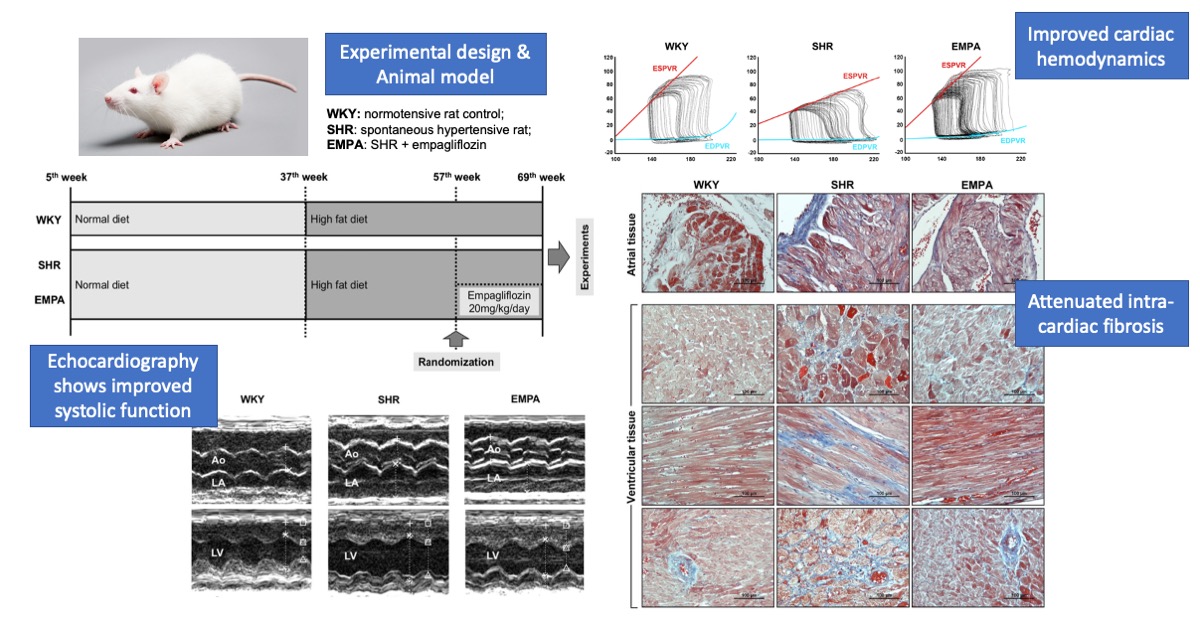
圖說:左上,高血壓心衰竭鼠之動物實驗模式與鈉-葡萄糖共同輸送器-2抑制劑 empagliflozin 治療組之實驗設計;empagliflozin藥物治療效果部分以下說明:左下,心臟超音波檢查顯示左心房擴大的減輕與左心室收縮功能的增進;右上,心導管檢查顯示心臟生理功能改善;右下,組織切片染色顯示心房與心室心肌內纖維化的減輕。
本篇為高雄醫學大學2019年月傑出論文4月份得獎文章,代表作者為高雄醫學大學附設醫院心臟內科李香君主治醫師。
本校主要研究者之簡介:
李香君主治醫師/副教授
高雄醫學大學醫學院國際組組長;高雄醫學大學附設醫院心臟內科主治醫師;高雄醫學大學醫學系內科副教授;中山大學醫學科技研究所合聘副教授;美國心臟病協會國際會士
研究聯繫Email:
hclee@kmu.edu.tw
期刊出處:
Lee et al. Cardiovasc Diabetol (2019) April; 18:45
期刊線上參閱網址:
The sodium–glucose co-transporter 2 inhibitor empagliflozin attenuates cardiac fibrosis and improves ventricular hemodynamics in hypertensive heart failure rats
Sodium glucose co-transporter 2 inhibitor (SGLT2i) is a new class of anti-diabetic drugs, and it acts on inhibiting glucose resorption by kidneys. Empagliflozin, one of SGLT2i in clinical use, has been shown beneficial in reduction of heart failure hospitalization and cardiovascular mortality. The heart protection effect seems independent from the blood glucose control. The protection mechanisms from SGLT2i to the heart remain unclear.
This study used a hypertensive heart failure animal model that was created by feeding spontaneous hypertensive rats (SHR) with high fat diet for 32 weeks. The elevated blood pressure and lipotoxicity caused atrial dilatation, left ventricular hypertrophy, intra-cardiac fibrosis and impairment of heart function. Half SHRs were randomized to be administered with SGLT2i, empagliflozin at 20 mg/kg/day for 12 weeks. Before the end of experiments, evaluation of electrocardiography and echocardiography, and invasive hemodynamic study were performed and followed by blood and tissue samples collection. The results showing benefits from empagliflozin in this hypertensive heart failure model are as following: (1) improved cardiac remodeling (improvement in atrial size and ventricular hypertrophy) ; (2) renal function improvement, while plasma glucose level unaffected; (3) normalization of both end-systolic and end-diastolic volume in SHR, in parallel with echocardiographic parameters improvement; (4) normalization of systolic dysfunction; (5) empagliflozin significantly attenuated cardiac fibrosis in both atrial and ventricular tissues; and (6) upregulation of atrial and ventricular expression of PPARα, ACADM, natriuretic peptides (NPPA and NPPB), and TNF-α in SHR, was all recovered by treatment of empagliflozin.
In short, empagliflozin improved atrial and ventricular remodeling, signaling pathways in heart failure, attenuated intra-cardiac fibrosis, improved hemodynamics in our hypertensive heart failure rat model. Our results contribute further understanding of the pleiotropic effects of empagliflozin regarding heart protection. The improvement of intra-cardiac fibrosis and the discovered modulated signaling pathway by empagliflozin will inspire more molecular biological studies, in order to find out more therapeutic targets for heart failure that is related to cardiac fibrosis.

Figure caption. Left upper. The experimental design for testing effects of empagliflozin on hypertensive heart failure model. The therapeutic effects are summarized as following: Left lower. Improvement of atrial and ventricular remodeling, and ventricular systolic function shown in echocardiography; Right upper. Improvement of cardiac hemodynamics in the empagliflozin group; Right lower: attenuation of intra-cardiac fibrosis in atrial and ventricular tissue histology.
Main researcher Intro.
Researcher:
Hsiang-Chun Lee, MD, MSc, PhD, FAHA
Director of Global Affairs, College of Medicine, Kaohsiung Medical University;
Cardiologist, Kaohsiung Medical University Hospital;
Associate Professor, Internal Medicine, School of Medicine, College of Medicine, Kaohsiung Medical University
Author Email
Paper cited from:
Lee et al. Cardiovasc Diabetol (2019) April; 18:45
Paper online website
【聲明啟事】針對網路詐騙治療近視眼藥水
近日有不肖業者,假藉本校名義,宣稱抗近視眼藥水誇大療效,並在網路平台進行販售。本校特別在此聲明,本校研發的眼藥水尚在試驗階段,並未有任何產品在市面上販售,該等廣告商品概與本校無關,請勿聽信網路不實廣告而受騙購買。
再次提醒,請勿聽信以下網站不實廣告而受騙購買: